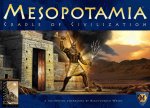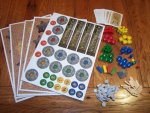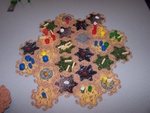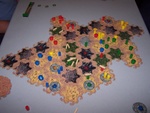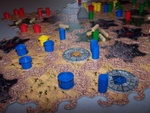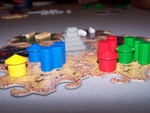
|
Mesopotamia A game by Klaus-Jürgen Wrede Published by Phalanx Games and distributed in the US by Mayfair Games, Inc. Players: 2-4 Time: 45 minutes Reviewed by Susan Rozmiarek |

|
Mesopotamia is one of the newer offerings by designer Klaus-Jürgen Wrede, known for his very successful Carcassonne series of games, and is being published by Phalanx and Mayfair Games. Players control nomadic tribes in ancient Mesopotamia, exploring, settling and building holy places. The game is essentially a race to fulfill certain victory conditions that uses exploration, resource management and pick-up and delivery mechanisms.
Components:
Mesopotamia comes in a large box with a custom insert full of high quality components. These include:
- 41 hexagonal tiles that form the game board. These have attractive artwork and are very nice because they interlock so as not to shift when bumped.
- 18 cards of good quality with a linen weave finish
- Wooden temple piece
- Wooden playing pieces in each of the four player colors - tribes, huts, and pawns and beams for the mana scale
- Additional cardboard player pieces on heavy stock - offering markers, holy places, and mana scales
- 20 wood resources - these are similar to the road pieces in Settlers of Catan
- 20 stone resources - these are real little stones, a very nice touch. My game actually came with almost twice the stated number of stones.
- Game overview with the starting set up. The overview is very helpful for learning and teaching the game
- Rules- these are in color and five pages long. Unfortunately, there were a couple of ambiguities that needed clarification. There is also a rules translation error that can have a major negative effect on the game. Please see the note below in the section about moving tribes.
Game play:
The object of the game is to be the first player to deliver his four offerings to the temple on the board. The game ends as soon as a player delivers his final offering and that player is declared the winner. The offering markers have a cost in mana on them - 2, 4, 6, and 7 that is required when delivering them to the temple.
The game overview shows the initial setup for various numbers of players. The temple is placed on a center tile with a volcano on either side. Two plains tiles are placed next to each other on one side of the temple and a forest tile and quarry tile with the corresponding resources are placed on the other side of the temple. Each player will start the game with three tribes and a hut on one of the two plains tiles. Each player also has in his personal supply, 6 additional tribes, 4 additional huts, 4 offering markers, 3 holy places and a Mana scale. The Mana scale is numbered from one to eight and has a marker to keep track of how much Mana a player has as well as a beam to show the maximum quantity he can possess. Players start the game with no Mana and a maximum of three. The deck of cards is shuffled and placed near the playing area as are the wood and stone resources. The land tiles are also shuffled and placed in a facedown stack.
Players take turns in clockwise order and each player's turn has three phases:- Move tribes
- Conduct Actions
- Gain Mana
Players have 5 movement points to spend each turn that can be divided up among their tribes on the board in any way they choose. Moving a single tribe to an adjacent tile costs one movement point. Each tribe can carry one item, a stone, wood or one of his offerings, and can pick up, drop and exchange items for no cost as they move. They can also steal a resource (but not an offering) from another player's tribe if they outnumber that tribe on a tile. There are also a few restrictions when moving. A tribe can never enter a volcano tile nor can they move through the temple tile carrying a resource. The exception is that they can enter the temple tile carrying a stone, but this stone will be taken to help build the temple (see below).
A player can help build the temple by moving onto the temple tile while carrying a stone. The stone is returned to the supply. Note: there is a translation error in the rules. The stone is NOT removed from the game. The player receives one Mana and also gets to increase his maximum Mana allowed by one. He moves his Mana marker and beam to reflect this. This is one of a couple of ways that a player can get Mana, but it is the ONLY way to increase his maximum.
During the movement phase, a player may also deliver an offering to the temple. He must have the necessary mana to do this as indicated on the offering token. When he moves onto the temple tile carrying the offering, he flips it over to show the players the cost and places it near the temple. He then pays the required mana by adjusting his mana marker. The tribe is removed from the board and placed back in his supply.
It is during the movement phase that a player can explore by moving a tribe off the board for the cost of one movement point. He then draws a new tile from the facedown stack. If it is a forest, plains, or quarry tile, he places it where his tribe explored and puts his tribe on it. However, if it is a volcano, he places it anywhere around the board and draws a new tile, repeating as necessary until he gets a tile on which to put his tribe. If the tile is a quarry he places a number of stones from the supply equal to the number of players, one on each quarry tile on the board, including the newly discovered one, with any extra going on the new tile. If he draws a forest tile, he does the same procedure but with wood instead of stone. This is how new resources come into the game.
Conducting Actions
A player may only choose one TYPE of action per turn, but with the exception of drawing a card, he may do that action multiples times if he is able. The actions are:
Build a hut - a maximum of two huts total can be built on a single plains tile. To build a hut, a player needs two tribes and a wood resource per hut built. He returns the wood to the supply and places one of his huts from his reserve on the tile. He then places one of his offerings facedown under the hut. This is the ONLY way to get offering markers on the board. If a player has multiple sets of tribes and wood he can build a hut for each set as long as there are no more than two huts per tile.
Build a holy place - This is similar to building a hut but it takes two tribes and a stone resource. Also, holy places can only be built on tiles containing no other huts, holy places, or enemy tribes. Holy places are used to gain Mana (explained later).
Population Growth - We refer to this as "having a baby." For every two tribes and a hut on the same tile, you may add a tribe from your supply to that tile. The tribes may be carrying an item, but there cannot be an offering under any hut on the tile. I'm not sure how this fits thematically, but it makes for a nice way to block another player from reproducing at a particular hut.
Draw a Card - This is the only action that is limited to once per turn. The cards do numerous things and are played at the appropriate time as indicated card. Some of the effects include stealing Mana from another player, giving birth to two tribes instead of one, extra movement points, etc. Some of them can be pretty powerful when played at the right time.
Efficiency is one of the keys to success in this game. Since you can only choose one type of action per turn, it is good to plan so that you can do a particular action multiple times when you choose it.
Gaining Mana
After a player has moved his tribe and taken his action, he now looks to see if he has tribes on tiles containing holy places. Each holy place will give him one mana point if he has one tribe present at his own holy place or two tribes present at an opponent's. He moves the marker on his Mana scale to indicate this without exceeding his maximum limit.
Play now moves to the next player and the game will end as soon as a player delivers his fourth and final offering to the temple.
Comments:
As with most games of this type, players may feel overwhelmed at the beginning with the need to do so many things. Your goal is to get your offerings to the temple, but first you must get them on the board and obtain the Mana to deliver them. But at the start, you are a long way to being able to do this. Your actions will build upon each other as you get more tribes on the board, explore, collect resources, build huts and holy places and deliver stones to the temple to increase your Mana limit. Some things, like stones, have dual purposes and you'll have to choose how to use them. Obviously, some planning is necessary, but the luck of event cards and exploration can create interesting tactical decisions that may change your plans.
A friend of mine aptly categorized Mesopotamia as a "snowball game." This is the type of game that plays in a crescendo fashion towards its conclusion, slowly building upon itself at the start but gradually gaining speed. I actually love this sort of game, with my very favorite being Roads & Boats, a Splotter game that is now out of print. Roads & Boats is very long, complicated and fiddly however, so it is difficult to find opponents willing to put the effort into playing it. Mesopotamia, on the other hand, is an excellent introductory game of this type. It plays in an hour or less and while the rules sound a bit complicated at first, they are really simple once you start playing the game. Most of my games have ended in a very tight and close finish between multiple players. The game seems to play equally well with two, three and four players since the number of plains tiles and resources are limited accordingly. Some veteran gamers may find it to be a bit too light and luck dependent for their tastes. I found it to be a fun, light alternative to heavier games of this sort and very suitable to play with my family or more casual gamers.
| Other Web information: |
This page viewed
E-mail Ed Rozmiarek with questions or problems concerning this page.
Copyright © 2006, Ed & Susan Rozmiarek. No portion of this website may be reproduced or copied without the consent of Ed or Susan Rozmiarek.
